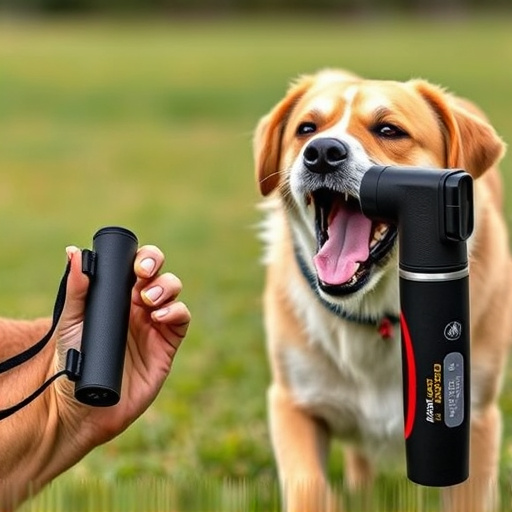Dog spray (mace spray) is a powerful tool for handling aggressive dogs, using capsicum to irritate and deter them. It should be used responsibly after exhausting other training methods, with proper understanding, precise following of instructions, safe distances, and skilled application to minimize harm. Effective dog sprays have specific components: active ingredients, concentration, and range. Mastering mace spray techniques through regular practice indoors and outdoors ensures optimal safety and efficacy as a deterrent, with ideal application distance of 2-3 feet. Training and controlled practice in various conditions build confidence for calm, measured responses during threats.
Dog spray, also known as mace spray, is a powerful tool for deterring aggressive canine behavior. Understanding its composition and safety is crucial before deployment. This article delves into the science behind dog spray, evaluating what makes it effective and how to use it responsibly. We’ll guide you through mastering mace spray techniques, ensuring optimal deterrence while providing practical tips on training and practice sessions. Learn how to effectively employ this tool with How to Practice Mace Spray Techniques for maximum safety and results.
- Understanding Dog Spray: Its Composition and Safety
- Evaluating Effectiveness: What Makes a Good Dog Spray
- Mastering Mace Spray Techniques for Optimal Deterrence
- Training and Practice: Ensuring Responsible Use of Dog Spray
Understanding Dog Spray: Its Composition and Safety
Dog spray, often referred to as mace spray for dogs, is a non-lethal deterrent designed to temporarily incapacitate or disrupt an aggressive canine. Its composition typically includes capsicum, a compound found in chili peppers, which irritates the dog’s eyes, nose, and respiratory system when sprayed. This irritation prompts the animal to flee or stop its unwanted behavior.
When using dog spray, safety is paramount. It’s crucial to understand that while it’s effective, it should be employed as a last resort when all other training and behavioral modification techniques have failed. Users must follow instructions carefully, ensuring they are at a safe distance from both the target dog and any bystanders. Regular practice of mace spray techniques can help individuals become more comfortable with its application, but it requires skill and responsibility to use it effectively while minimizing harm or stress to animals and people alike.
Evaluating Effectiveness: What Makes a Good Dog Spray
Evaluating a dog spray’s effectiveness involves understanding what constitutes a good deterrent. Key factors include the spray’s active ingredients, concentration, and range. A reputable dog spray should contain safe yet potent substances that trigger an unpleasant response in dogs, discouraging unwanted behavior like barking, aggression, or marking territory. The concentration of these ingredients plays a crucial role; higher concentrations offer more protection but require careful handling to ensure safety.
Additionally, the spray’s range matters for effective use. A good dog spray should have a reach that allows you to deter your pet from a safe distance, especially in situations where close contact might be dangerous or uncomfortable. Practicing mace spray techniques, such as aiming correctly and understanding the spray’s duration, is essential. How to Practice Mace Spray Techniques guides users through these steps, ensuring the product is used optimally for maximum effectiveness without causing harm.
Mastering Mace Spray Techniques for Optimal Deterrence
Mastering Mace Spray techniques is key to ensuring its safety and effectiveness as a deterrent. Proper practice involves understanding the ideal distance for application, which typically ranges between 2-3 feet away from the target. This precision ensures that the spray reaches the intended area without risking exposure to bystanders or yourself.
When practicing, focus on consistent hand-eye coordination. Hold the can steadily and angle it correctly to cover the desired space effectively. Regular drills, both indoors and in simulated outdoor settings, help hone these skills. Additionally, learning proper ventilation techniques is crucial, especially in enclosed spaces, to prevent the buildup of irritants and ensure minimal risk during use.
Training and Practice: Ensuring Responsible Use of Dog Spray
Training and practice are paramount when it comes to ensuring responsible use of dog spray, also known as mace spray. It’s crucial to familiarize yourself with the proper handling techniques and safety precautions before ever needing to deploy the spray. Start by learning the different types of dog spray devices available, their trigger mechanisms, and range. Practice in a controlled environment, like an open field or your backyard, to get a feel for the spray pattern, wind conditions that might affect its reach, and how quickly it dissipates.
Role-playing scenarios with a trusted partner can help simulate real-life situations. This practice should include both offensive and defensive positions, allowing you to experiment with different spraying angles and distances. Remember, the goal is not only to deter an attacking dog but also to minimize harm to both yourself and the dog if necessary. Regular practice sessions will build confidence and muscle memory, ensuring a calm and measured response when facing a real threat.
Dog spray can be an effective deterrent when used responsibly. Understanding its composition, evaluating its effectiveness, and mastering proper techniques are crucial steps in ensuring its safe deployment. Regular training and practice, as outlined in this article, will help users make informed decisions and employ mace spray effectively while minimizing harm to both dogs and their owners. Remember, responsible use is key to maintaining a safe and controlled environment for all.
